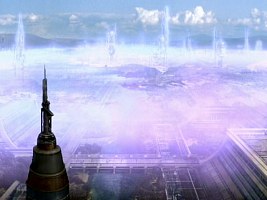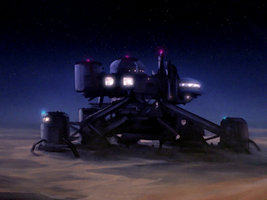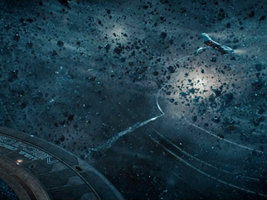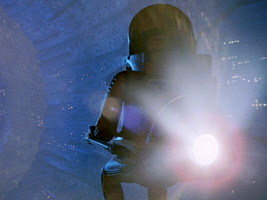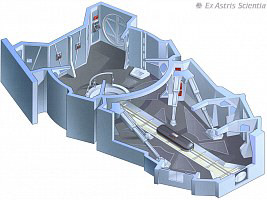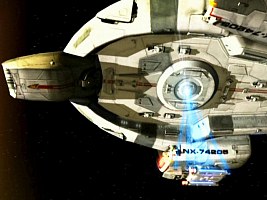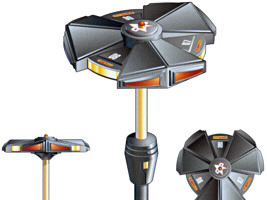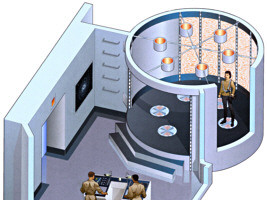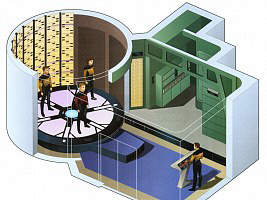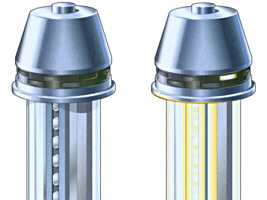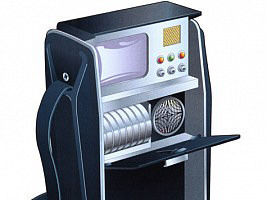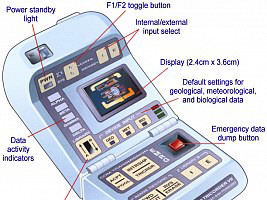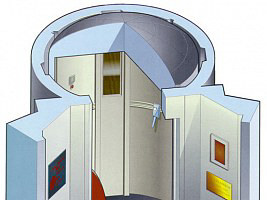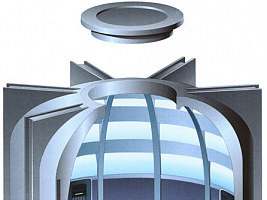Treknology Encyclopedia - T
T-9 energy converter Power device used in the Federation (TNG: "The Last Outpost").
Such a device was stolen by the then-unknown Ferengi in 2364.
T-cell stimulator Medical device that increases the production of T-cells to strengthen the immune system (TNG: "Identity Crisis").
Tachyon detection grid Network of starship-based tachyon emitters used to detect cloaked vessels, particularly Romulan ships supporting the Duras family in the Klingon Civil War (TNG: "Redemption, Part II", DS9: "Apocalypse Rising").
Tachyon scan Method to detect cloaked vessels using a tachyon beam (TNG: "The Pegasus", VOY: "Flashback", "Star Trek Nemesis").
Single ship-mounted tachyon emitters were apparently insufficient for the surveillance of the Klingon-Romulan border, so the method was extended to the tachyon detection grid in TNG: "Redemption, Part II". Shinzon's Scimitar proved untraceable as the vessel lacked tachyon emissions.
Tactical alert State on increased readiness on 22nd century Earth starships, about equivalent to red alert. First introduced by Malcolm Reed in 2152 (ENT).
Trip, who was working on the improvement of the captain's chair under the influence of the anomaly, called it "Reed Alert" at one point (ENT: "Anomaly").
Tantalus field Remote-controlled anti-personnel weapon developed in the Mirror Universe in the 23rd century (TOS: "Mirror, Mirror").The device could be controlled through a normally covered monitor in Mirror Kirk's quarters. We do not know how the actual weapon on the other side looked like, however. We can only conjecture that it was a drone silently hovering above the ground with a targeting camera and some sort of beam emitter.
Targeting scanner Instrument in the helm console on the bridge of a Constitution-class starship that automatically deployed when needed (TOS, Star Trek Encyclopedia II).
This refers to the little viewer that occasionally popped up from Sulu's console. There does not seem to be a firmly established name for it. The Encyclopedia goes with "targeting scanner".
Telekinetic suppression collar Device that inhibits telekinetic activity (DS9: "The Jem'Hadar").
In the particular case of the DS9 episode the device was a fake, as Eris worked together with the Jem'Hadar who had "captured" her, and was later reveled to be a Vorta.
Temporal communicator Device that allows communication with a different time. 31st century temporal communicators require a quantum discriminator to work (ENT: "Shockwave, Part II"). See also temporal transmitter.
Temporal incursion Generally, any alteration of history. Specifically, a method that erases a target object from space-time in a way that it has never existed. Temporal incursion is equivalent to traveling back in time and removing or destroying the respective object (VOY: "Year of Hell").The Krenim scientist Annorax carried out countless incursions in order to restore the Krenim Imperium (see Time Travel in Voyager).
Temporal mechanics Study of time and of manipulations of the time continuum (DS9: "Visionary", "Trials and Tribble-ations", VOY: "Year of Hell").
"I hate temporal mechanics." (Miles Edward O'Brien, "DS9: "Visionary")
Temporal transmitter Borg device capable of transmitting messages to drones in another time (VOY: "Timeless").
Temporal vortex Time travel method. Artificially generated conduit leading to another time. In particular, the vortex opened by the Borg to the year 2063, in an effort to prevent Earth's first warp flight from happening ("Star Trek: First Contact").
Temporal weapon ship Huge starship devised by Krenim scientist Annorax to alter history through temporal incursion, a weapon of temporal mass destruction. The weapon ship is equipped with a temporal core whose output beam may be focused on a target. When a target is hit, every single particle of it is erased from history as if it had never existed. This evokes far-flung alterations of history whose complete extent remains incalculable. While the rest of the universe is fully exposed to the altered history, the weapon ship itself is shielded against changes in the timeline (VOY: "Year of Hell").
Ironically the weapon ship eradicates itself in the end, when its temporal core implodes, hence reverting all previous incursions (or so it seems).
Tentacle Specifically, as a weapon, highly flexible mechanical appendages that are used to tap into control or power systems of an enemy ship or other enemy technology (PIC: "Et in Arcadia Ego II", "The Star Gazer").
 Tentacles are common in Discovery where they appear as technology from an unknown future and from the 32rd century, respectively. We can surmise that these latter tentacles are made of programmable matter (DIS: "Light and Shadows", "Su'Kal").
Tentacles are common in Discovery where they appear as technology from an unknown future and from the 32rd century, respectively. We can surmise that these latter tentacles are made of programmable matter (DIS: "Light and Shadows", "Su'Kal").
Terraforming Generic name for technologies to convert a desolate planet into an inhabitable Class-M world (generic).
In TNG: "Home Soil" the terraforming project had to be stopped after intelligent life had been detected on the allegedly desert planet. Still, it is not reasonable why the Federation abandoned the Genesis project that was far more advanced and powerful than all subsequent methods.
Terrasphere Huge space station built by Species 8472 to simulate possible targets for infiltration or invasion. In order to perfect the authenticity, Species 8472 assumed human bodies during the training (VOY: "In the Flesh").
The Terrasphere 8 seen in "In the Flesh" contained Starfleet Headquarters and a part of the city of San Francisco. It is frightening to imagine that they built at least seven other terraspheres.
Test cylinder See transporter test cylinder.
 Tether Specifically, as a 32rd century technology similar to the tentacles that are used as weapons, a rope that connects two starships and is made of programmable matter (DIS: "Anomaly").
Tether Specifically, as a 32rd century technology similar to the tentacles that are used as weapons, a rope that connects two starships and is made of programmable matter (DIS: "Anomaly").
Tetryon pulse launcher Portable Starfleet weapon of the 24th century ("Star Trek: Insurrection").
The tetryon pulse launcher, like the isomagnetic disintegrator that Worf is purportedly carrying, was mentioned but not clearly identified in the movie.
Thermal chamber Facility on Xindi-Reptilian vessels giving the cold-blooded species an opportunity to warm up (ENT: "The Council", "Countdown").
Thermal deflector Protective forcefield erected against firestorms on the planet Bersallis III (TNG: "Lessons").
Thermal regulator Part of a starship's life support systems, also an engineering tool (VOY: "Nightingale", "Shattered").
In "Nightingale" B'Elanna reported the condition of the ship's regulators that were "still running a little hot". In "Shattered" Janeway used a tool of the same name in an attempt to repair her replicator (without much success, as we can easily imagine).
Thermal stabilizer Part of a weather modification net (TNG: "Force of Nature").
Theta-matrix compositor Component of the warp drive of recent Federation starships, such as the Galaxy and the Intrepid class. The compositor accomplishes the recrystallization of dilithium crystals without the need to remove them from the articulation frame inside the warp core. As of the mid-24th century Excelsior-class ships are not equipped with this technology (TNG: "Family", VOY: "Innocence").
Thought maker Device of Ferengi origin that is used to manipulate thoughts and make a person susceptible to suggestion. The thought maker consists of one transmitter and one receiver, both spherical in shape. It is illegal even within the Ferengi Alliance (TNG: "The Battle").
In later TNG and DS9 installments we can see spheres that look just like the thought maker as control consoles on Ferengi vessels.
Thruster suit Spacesuit with a built-in thruster pack ("Star Trek: The Motion Picture"). Time bug Also known as chronophage, Krenim-made temporal weapon that randomly cycles a ship and its crew through time. The bug is protected by a temporal shield (DIS: "Face the Strange").
Time bug Also known as chronophage, Krenim-made temporal weapon that randomly cycles a ship and its crew through time. The bug is protected by a temporal shield (DIS: "Face the Strange").
Chronophage literally means "time eater". It is a key element of the story that Rayner and Burnham are not transferred to a another version of the ship, but the ship itself and the complete crew (with the exception of these two) gets reverted to a former state. Everyone else becomes their former self, as is evidenced by Stamets, who suddenly wears an old blue uniform but has all the memories from the 32nd century. There are precedents of such a phenomenon in Star Trek, such as notably in VOY: "Before and After". But it makes still less sense here how the ship and everyone aboard travels through time and space to merge with the former (and sometimes later) version. Where do crew members go to that are not aboard at the destination? Or that would die? Where do crew members come from that are aboard at the destination but not at the origin? Does the time bug decide which matter needs to be recombined, which can be used without a change, and the rest somehow goes into storage for the next jump?
Time dilation General or special relativistic effect that occurs either in the vicinity of a mass concentration (see black hole, event horizon) or at high relative speeds (see relativistic speed), respectively (generic).
Time travel Usually any movement through time that is not equivalent to the normal course of time, in particular a person's travel leading either to the past or faster as usual to the future. Time travel to the past may entail paradoxes or causality loops, if an effect becomes apparent before the cause exists (generic).
These and other problems of time travel are extensively discussed in Time Travel - General Considerations. Traveling at relativistic speeds will allow time travel to the future, however, with no return. A kind of time travel to the past is evident in the case of two correlated photons, when one photon immediately changes to a certain state once the state of the other photon is determined. This is only possible with an FTL signal transfer or a wave function traveling to the past.
 In "Star Trek (2009)" the issues of time travel are dealt with in a totally different fashion than in all previous Star Trek installments. The characters accept the new reality as it is instead of doing everything to fix the damage that Nero has done. The behind-the-scenes rationale is that Nero's time travel created a new universe that exists in parallel to the original one, rather than replacing it.
In "Star Trek (2009)" the issues of time travel are dealt with in a totally different fashion than in all previous Star Trek installments. The characters accept the new reality as it is instead of doing everything to fix the damage that Nero has done. The behind-the-scenes rationale is that Nero's time travel created a new universe that exists in parallel to the original one, rather than replacing it.
Timeship Vessel capable of traveling through time generating temporal rifts (VOY: "Future's End", "Relativity").
The 29th century Federation timeships Aeon and Relativity are part of a Federation institution seeking and preventing manipulations in the timeline.
Tomographic imaging scanner Advanced sensor with multiphasic resolution and the ability to penetrate could penetrate subspace interference. The Daystrom Institute started its development in 2360. While no functional device was available in 2364, the Enterprise-D was equipped with one by 2370 (TNG: "All Good Things").
It is not evident if and how the principle of the tomographic imaging scanner can be related to present-day tomographic technology. The latter necessitates scans from different directions, but in the TNG episode none of the three vessels circumnavigated the anomaly to scan it.
Torpedo bay Facility on a starship from where spatial torpedoes (22nd century), photon(ic) torpedoes and probes can be launched. In the torpedo bay the torpedo launchers are automatically or manually loaded (generic).Although photon and the perhaps smaller quantum torpedoes may share their launch bays on some modern ships, we have never seen a launch bay for quantum torpedoes from the inside. The according facilities on a Defiant class or on a Sovereign class (the latter just above the windshield of the captain's yacht) must be so small that they are not normally accessible and hence fully automated.
Torpedo launcher Acceleration tube for torpedoes (generic).
The launcher on 23rd century vessels seem to be at least partially open and accessible ("Star Trek II", "Star Trek VI"). In contrast, the corresponding part on Enterprise NX-01 is built like a torpedo tube on a submarine, with a solid hatch that is closed prior to the launch.
Tox Uthat Quantum phase inhibitor developed by Kal Dano in the 27th century (TNG: "Captain's Holiday").
TR-116 Type of an advanced projectile weapon (DS9: "Field of Fire").
Tractor beam Device used by Federation starships to hold and tow other vessels. Apart from the main emitter and optional auxiliary emitters located around the hull, a small tractor beam emitter is located in each shuttle bay to control the landing procedure. Tractor beams are based on a subspace field assisted emission of gravitons, their direction can be reversed to push away an object. Starfleet ships were not yet so equipped in the 2150s but with a mechanical grappler. At that time the Vulcans and Klingons already had tractor beam generators. (TNG, DS9, VOY, ENT).DS9: "Paradise" established that locking the tractor beam on a ship at warp poses a high risk to both vessels. It does not seem to be a problem to go to warp after the tractor beam has locked, however.
Trajector Transporting device used by the Sikarians with a range of 40,000 light years (VOY: "Prime Factors").
This device is possibly based on space folding.
Transgenic weapon Biological weapon that made use of a synthetic biotoxin (ENT: "The Seventh").
Menos secretly supplied components for a transgenic weapon.
Translation matrix Piece of software that is a part of many communication and computing devices and of all universal translators. Linguacode is a very common translation matrix developed by Hoshi Sato in the 22nd century (generic).
Translocator Nyrian device to transport objects or persons across distances as great as 10 light-years (VOY: "Displaced").
Nothing more is known about the device, but it may work similarly as the subspace transporter.
Transluminal processor Key component of a Federation computer system. Allows processing data at faster-than-light speeds (VOY: "Concerning Flight").
Transmuter Device used by the aliens Sylvia and Korob to exert physical force, transform matter and control minds with their amplified mental power (TOS: "Catspaw").
Transpectral sensor array 24th century Mirror Universe sensor device. The device could penetrate the interference caused by plasma storms (DS9: "Through the Looking Glass").
The Alliance assigned Jennifer Sisko to work on such a sensor, as they wanted to locate Terran bases that were hidden in the Badlands.
Transphasic torpedo Future weapon technology that was prematurely introduced by USS Voyager to defeat the Borg in 2378 (VOY: "Endgame").
It seems that transphasic torpedoes are related to phase cloaks. This would imply that conventional shields would be useless against them.
 Transpo lock Device that facilitates the transport of an object from environments with interference, essentially a 32nd century pattern enhancer (DIS: "Lagrange Point").
Transpo lock Device that facilitates the transport of an object from environments with interference, essentially a 32nd century pattern enhancer (DIS: "Lagrange Point").
The Starfleet devices probably do not work the same way as the Cardassian transport scramblers below. Most likely they prevent the transporter beam from locking on in the first place, as they are not meant to kill anyone, but on the contrary, to protect the Ba'ku.
Transport scrambler Device that inhibits transporter activity. More specifically, the Cardassian-built transport scramblers or pattern scramblers are designed to interfere with the annular confinement beam (ACB) that controls the (re-)materialization process, thereby destroying transporter patterns (DS9: "Nor the Battle to the Strong", "Empok Nor", "Change of Heart").
The Klingon scramblers from DS9: "Nor the Battle to the Strong" may work in a similar fashion.
Transporter Device that is able to dematerialize, transmit and reassemble an object. Cargo transporters have a limited resolution and are employed for transport of inanimate objects. Personnel transporters work on the quantum level and employ Heisenberg compensators to enable secure transport of lifeforms. A transporter room typically consists of an operator console, a transporter platform and an overhead molecular imaging scanner, primary energizing coils and phase transition coils. A pattern buffer with a biofilter is located on the deck below. The outer hull of a starship incorporates a number of emitter pads for the transporter beam. A typical transport sequence for the beam-down of a person begins with a coordinate lock during which the destination is verified and programmed. Next, the lifeform to be beamed is scanned on the quantum level and simultaneously converted to a matter stream. This process is determined by an annular confinement beam (ACB). The matter stream is briefly stored in the pattern buffer tank and then transmitted through an emitter pad. Finally, the person is reassembled at the destination. Usually transporters cannot be used while the deflector shields of the ship are active.The transporter is the most controversial regular device in Star Trek, and some of its many oddities are discussed on the transporter inconsistencies page. The fact that transporter patterns are often handled the same way as computer data, although they are supposed to be a matter stream, is unfortunately not addressed in the TNG Technical Manual. An explanation on how a person can be reassembled on an unknown planet is missing as well. Transport at warp velocities is regarded possible as long as both starships travel at exactly the same warp factor. Smaller relative motions can be compensated by a Doppler compensator. While the normal recommended transportation range is 40,000 km, it can be assumed that under ideal conditions, in particular if two transporter systems are involved, this range can be significantly extended. This is what Rick Sternbach wrote about the transporter in his newsgroup (posted 07.04.99): "The transporter definitely uses the person's (or object's) own matter and transmits it over a jacketed beam. While it uses a lot of the same field manipulation technologies as a replicator, it doesn't replicate the person (or object). The fact that we've heard people talking in the transporter beam seems to say that you don't get unzipped in a linear fashion (like from the top of your head to your toes), but more like atoms taken from all over, randomly, but with all the quantum state and position data temporarily recorded for reassembly. It's pretty analogous to the difference between recording a television broadcast (replicator) and simply sending out a live broadcast (transporter), because in the case of the latter, there's just too much data to record, at least with Federation technology."
Transporter sensor log Record of transporter activity. The sensor log allows to reconstruct a transport sequence, especially as a diagnostic after a malfunction (TNG: "Attached").
Transporter test cylinder Container holding a molecular matrix of various organic and anorganic compounds, suited to test the proper function of a transporter. The Federation as well as the Romulans are using such devices (VOY: "Eye of the Needle").In TNG: "Hollow Pursuits" we saw transporter test cylinders of a different kind. They seemed to consist of pure metal.
Transtator Basic device of Federation technologies, especially of communicators (TOS: "A Piece of the Action", DS9: "Hippocratic Oath", "Trials and Tribble-ations", "In the Cards", "The Siege of AR-558", VOY: "Time and Again").
The intentional analogy to the transistor is undeniable, although the transtator seems to be something discrete, as opposed to the highly integrated transistors of our days. In TOS: "A Piece of the Action", Kirk mentions the transtator in a communicator, and in DS9: "The Siege of AR-558", the engineer asks Ezri Dax to repair a transtator, which is part of the communications array. In DS9: "Hippocratic Oath" there is a transtator interface in a scanner, possibly of the scanner's transceiver part. On the other hand, in DS9: "Trials and Tribble-ations", the transtator looks like it is a part of the power system because O'Brien removes one from a panel, which turns off the lights on the deck. But he was mistaken about the function of the device anyway, so it may not have been actually a transtator.
Transwarp Fundamentally a generic term for technologies that overcome the limitations of conventional warp drives, specifically an experimental propulsion principle tested with the USS Excelsior NX-2000 ("Star Trek: The Search for Spock", TNG: "Descent", VOY: "Threshold", "Distant Origin").
Transwarp technology is also used by the Borg in TNG: "Descent", however, it is not known if it is the same principle as in "Star Trek: The Search for Spock". The Voth are another race using transwarp (VOY: "Distant Origin").
Transwarp coil Essential part of a Borg transwarp drive. Enables propulsion at speeds faster than warp (VOY: "Dark Frontier").
The transwarp coil is not only a bad example of alien technology that is made work on a Starfleet ship with minimum effort. It also questions the whole principle of a warp drive, because a warp coil is firmly established as a huge field generator inside the nacelles. The portable "transwarp coil" in "Dark Frontier", on the other hand, looks like a part of the power system. Why should the ship be substantially faster just because of a modification to the power system? Can a Ford Pinto cross the sound barrier just by using special fuel? Unfortunately, the author of ENT: "Damage" took it for granted that if a transwarp coil is a small device somewhere in a corner of main engineering, the same must apply to a normal warp coil...
 Transwarp beaming Transporter technology that allows to beam a person or object across a distance of many light years, to a remote planet or even to a ship traveling at warp. The technology was developed by Montgomery Scott in the 24th century of the Prime Universe, from where Ambassador Spock took it to the 23rd century of the Alternate Universe ("Star Trek (2009)", "Star Trek Into Darkness").
Transwarp beaming Transporter technology that allows to beam a person or object across a distance of many light years, to a remote planet or even to a ship traveling at warp. The technology was developed by Montgomery Scott in the 24th century of the Prime Universe, from where Ambassador Spock took it to the 23rd century of the Alternate Universe ("Star Trek (2009)", "Star Trek Into Darkness").
Transwarp beaming should not be confused with transwarp propulsion. Rather than that, it may be related to the subspace transporter of the Ferengi or the Dominion. The Alternate Universe Scotty describes the idea as follows: "The notion of transwarp beaming is like trying to hit a bullet with a smaller bullet, whilst wearing a blindfold, riding a horse."
Tricobalt device Explosive device used on the planet Eminiar VII and later adopted for Federation starships (TOS: "A Taste of Armageddon", VOY: "Caretaker", "Blink of an Eye").
Tricobalt devices seem to be rather old-fashioned yet efficient weapons if they are used against targets with limited or no defense, such as in TOS: "A Taste of Armageddon" and VOY: "Caretaker".
Tricorder Hand-held sensing, computing and communication device for use by Starfleet personnel. The tricorder incorporates sensor and computer systems in a miniaturized version with limited capabilities, yet sufficient for away missions (generic).
Considering the ongoing miniaturization of computer as well as sensor elements in the real world, it will soon be feasible to design a fully functional tricorder. However, it is doubtful whether there will be a need for such a device, at least in the foreseeable future, for it would be too sophisticated for a consumer product and not specialized enough for a scientific apparatus. On the other hand, considering that cell phones have been turned into Swiss army knives by the marketing people rather than by the engineers, who knows which technical devices we are supposed to carry along in the future?
Trinary syntax Computer language used by various species (VOY: "Hope and Fear").
Language genius Arturis was familiar with trinary syntax. Perhaps it is a representation of a trinary/ternary logic (do not confuse that with a tri-state gate which is still binary with an additional "off" state!). Yet, ternary logic has proven to be too complex in its implementation compared to the reduction of the code length.
Trionic initiator Component inside a starship's warp core. The initiators may create subspace phenomena as side effects in rare cases (TNG: "Interface").
The actual function of this device is unclear.
 Trynar shield Deflector shield erected around the Detrion system by Nick Locarno. The Trynar shield acts much like a solid wall and can only be penetrated using a massive amount of energy (LOW: "Old Friends, New Planets").
Trynar shield Deflector shield erected around the Detrion system by Nick Locarno. The Trynar shield acts much like a solid wall and can only be penetrated using a massive amount of energy (LOW: "Old Friends, New Planets").
The turbolift is a nice example for real world technology adapted for Star Trek (although the details are given only in the TNGTM). Linear motors have actually been developed for transportation purposes, for instance in the Transrapid. Fundamentally, such a motor works in a similar way as a conventional cylindrical electric motor, where a rotor is located inside a stator. The linear motor has the stator unrolled, and the rotor can be replaced by a simple magnet in the car that is free to move along the stator in the roadway. Propulsion is achieved by powering the stator in a way to generate a traveling field.

In the Discoverse, turbolifts don't seem to connect any decks and there are no turboshafts, but they are running across the largely empty interior like a rollercoaster (DIS: "Brother", SHO: "Q&A"). In the 32nd century, there are no rails any longer, but the turbolifts are free floating within the Discovery (DIS: "That Hope Is You, Part 2").
Turboshaft Horizontal or vertical passageway for the turbolift (generic).

Back to Treknology Encyclopedia index






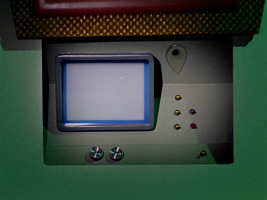
 Tantalus field control panel in TOS: "Mirror, Mirror"
Tantalus field control panel in TOS: "Mirror, Mirror"